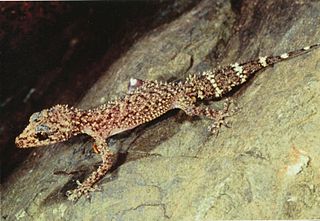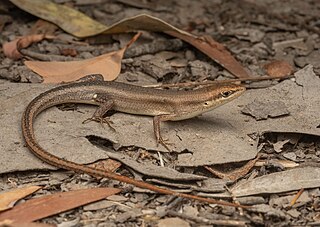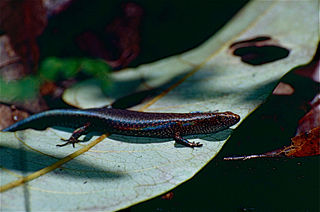Allan's lerista, also known commonly as Allan's skink and the greater robust fine-lined slider, is a species of skink, a lizard in the family Scincidae. This rare species is endemic to Queensland, Australia.
The Satinay sand skink, also known commonly as the Fraser Island sand skink, is a species of lizard in the family Scincidae. The species is native to Australia.

Champion's leaf-tailed gecko, also known commonly as the Koumala leaf-tailed gecko, is a species of gecko, a lizard in the family Carphodactylidae. The species is endemic to Australia.
Orraya is a monotypic genus of lizard in the family Carphodactylidae. The genus contains the sole species Orraya occultus, also known commonly as the McIlwraith leaf-tailed gecko or the long-necked northern leaf-tailed gecko. The species is endemic to Australia.

Hosmer's spiny-tailed skink, also known commonly as Hosmer's egernia and Hosmer's skink, is a species of large skink, a lizard in the family Scincidae. The species is a diurnal, rock-dwelling species native to Northern Australia.
The red-tailed soil-crevice skink, also known commonly as Kinghorn's grassland striped skink and Kinghorn's snake-eyed skink, is a species of skink, a lizard in the subfamily Eugongylinae of the family Scincidae. The species is endemic to Australia.

Carlia jarnoldae, also known commonly as the lined rainbow-skink or the lined rainbow skink, is a species of lizard in the subfamily Eugongylinae of the family Scincidae. The species is endemic to the state of Queensland in Australia.

Carlia storri, also known commonly as the brown bicarinate rainbow-skink or Storr's carlia, is a species of lizard in the family Scincidae. The species was first described by Glen Joseph Ingram and Jeanette Covacevich in 1989. It is native to Papua New Guinea and the Australian state of Queensland.
Cryptoblepharus fuhni, also known commonly as the black-boulder shinning-skink, is a species of lizard in the family Scincidae. The species is endemic to Queensland in Australia.

Lampropholis coggeri, also known commonly as the northern sun skink and the rainforest sunskink, is a species of lizard in the family Scincidae. The species is endemic to Queensland in Australia.

Lampropholis couperi, commonly known as the plain-backed sunskink, is a species of skink, a lizard in the family Scincidae. The species is endemic to Queensland, Australia.
Lygisaurus tanneri, also known commonly as the Endeavour River litter-skink and Tanner's four-fingered skink, is a species of lizard in the family Scincidae. The species is endemic to Australia.
Proablepharus tenuis, also known commonly as Broom's small skink and the northern soil-crevice skink, is a species of skink, a lizard in the family Scincidae. The species is endemic to Australia.

Saproscincus czechurai, also known commonly as Czechura's litter-skink, Czechura's skink, and the wedge-snouted shadeskink, is a species of lizard in the family Scincidae. The species is endemic to Queensland in Australia.
Saproscincus hannahae, also known commonly as Hannah's shadeskink and Hannah's shade-skink, is a species of lizard in the family Scincidae. The species is endemic to Queensland in Australia.
Saproscincus lewisi, also known commonly as the Cooktown shade-skink and the northern wet tropics shadeskink, is a species of lizard in the subfamily Eugongylinae of the family Scincidae. The species is endemic to Queensland in Australia.
Concinnia frerei, also known commonly as the stout bar-sided skink or the stout barsided skink, is a species of lizard in the family Scincidae. The species is endemic to Queensland in Australia.
The nubbinned fine-lined slider is a species of skink, a lizard in the family Scincidae. The species is endemic to Queensland in Australia.
Lerista emmotti, also known commonly as the Noonbah robust slider, is a species of skink, a lizard in the family Scincidae. The species is endemic to Queensland in Australia.
Lerista ingrami, also known commonly as the McIvor River slider, is a species of skink, a lizard in the family Scincidae. The species is endemic to Queensland in Australia.







